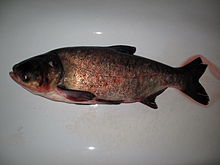
Aristichthys nobilis

The bighead carp (Hypophthalmichthys nobilis) is a species of freshwater fish, one of several Asian carps. It is one of the most intensively exploited fishes in aquaculture, with an annual worldwide production of over three million tonnes in 2013, principally from China. The bighead carp has a large, scaleless head, a large mouth, and eyes located very low on the head. Adults usually have a mottled silver-gray coloration. It is a large fish; a typical length is 60 cm (2 ft), and maximum observed size of 146 cm (4 ft 9 in) and 40 kg (88 lb). Bighead carp are native to the large rivers and associated floodplain lakes of eastern Asia. Their range extends from southern China north to the Amur River system, which forms the border between China and Russia. They have been introduced widely outside their native range, including the United States, and they are considered invasive, as they out-compete native species (e.g. Bigmouth Buffalo). The bighead carp has a very fast growth rate, which makes it a lucrative aquaculture fish. Unlike the common carp, bighead carp are primarily filter feeders. They preferentially consume zooplankton, but also phytoplankton and detritus. The bighead carp is an important species in aquaculture, having the fifth-highest production (7.5%) of all cultured freshwater fish worldwide. Its production grew from just 15,306 tonnes in 1950 to 3,059,555 tonnes in 2013, most of the growth being in China. The value of bighead carp as a food fish has caused it to be exported from its native China to more than 70 other countries, where it has invariably escaped or been intentionally released to the wild. Today, the bighead carp can be found in the wild in Europe, South America, and North America. It also has been introduced into most of the Indian subcontinent (India, Pakistan, and most Southeast Asian countries) and to lakes in western China to which it is not native. Bighead carp are not always considered undesirable, invasive species where they are introduced outside their native range, and they continue to be stocked in some water bodies to support commercial fisheries. Stocking bighead carp or silver carp usually increases the total biomass of fish available for harvest, but can decrease the catch of native and sometimes more valuable fish. Bighead carp are considered a highly destructive invasive species in the United States. Bighead carp and the closely related silver carp (H. molitrix) were imported to the United States to remove excess or undesirable plankton, thus improve water quality in sewage treatment plants and aquaculture facilities. However, some fish escaped into the Mississippi River basin, where they are now firmly established. A national plan for the control of Asian carps, including bighead carp, was finalized in late 2007. In the United States, a limited market has developed for bighead carp, particularly in ethnic communities, and they are farmed in ponds for this purpose. The live or very freshly killed market is most lucrative. Because of this, bighead carp are often transported live, and may be a high risk factor for the eventual spread of the fish, either through release by the end purchaser, or through escape during transport. Another potential avenue for unintentional spread of bighead carp is through use as fishing bait.
